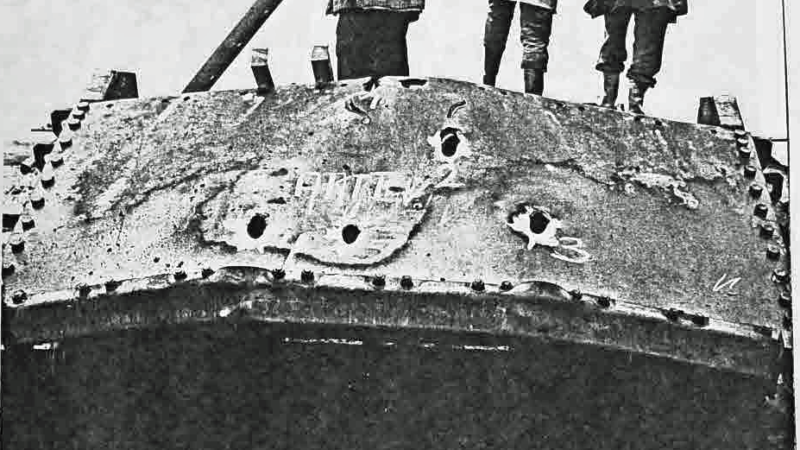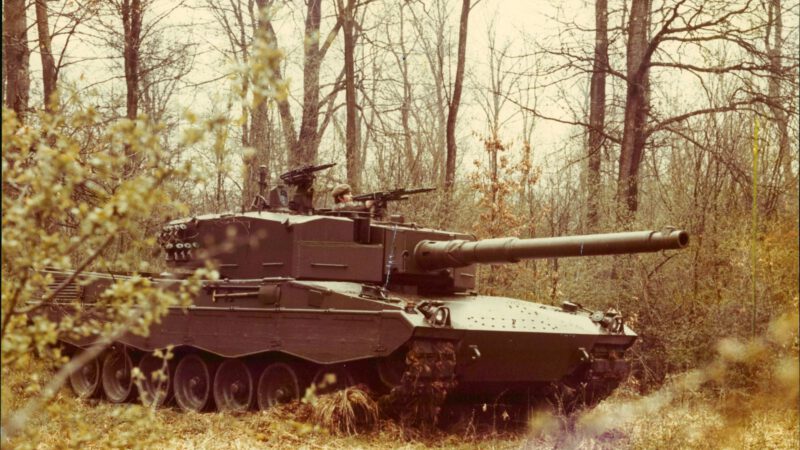German experimental armor development II: results of trial program 16, 21 and 22
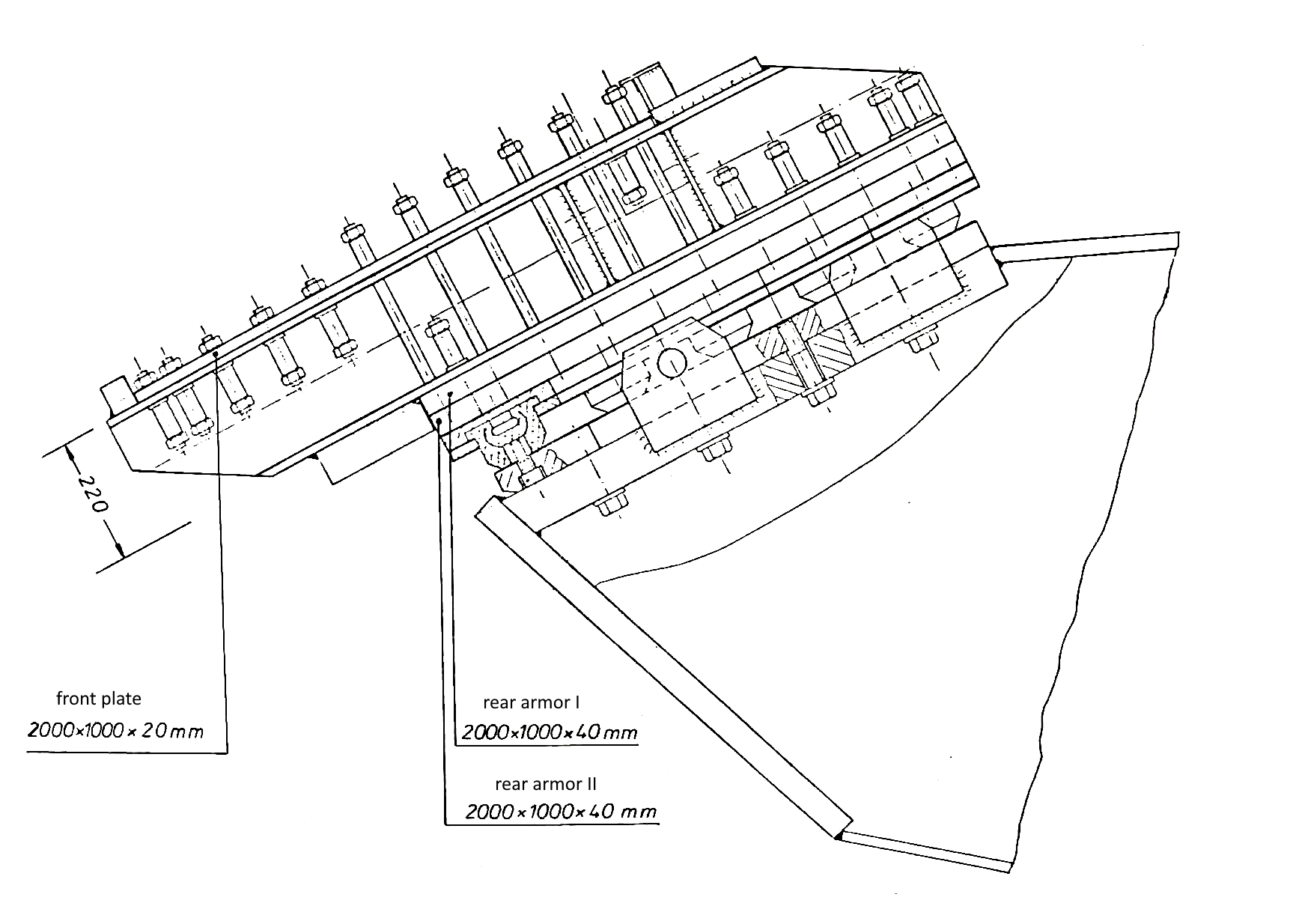
2. Trial results
The results from the firing trials on the WTD’s Erprobungsstelle (testing site) 91 are summarized in this article. The IABG company summarized the results of each shot in an own table, using nomenclature common with the Bundeswehr.
In the test protocols the following abbreviations find usage, which are also commonly used at the testing site 91 of the Bundeswehr in Meppen:
OW – not counted
OM – no mark (on the back side)
BOR – bulge without crack
D – penetration
B – TU 1911/00 page 16
Due to the different form of presentation, these original tables will (containing lots of identical or near identical entries) will not be included in this article, but instead a short summary in a table is given in each corresponding section.
2.1 Test protocol of trial program 16
The target in trial program 16 was mounted on a (apparently simulated) Leopard 1 hull front consisting of 70 mm armor-grade steel sloped at 60° NATO angle. All plates were parallel to each other. The targets are described in greater detail in the first part. The target was formed by a 20 mm front plate mounted with a 20 mm stand-off distance in front of an “active sandwich” (ERA tile) consisting of two 10 mm thick steel plates with a four millimetre thick interlayer of Dottikon (a mixture of 85% PETN and 15% natural rubber). Spaced 176 mm behind the ERA panel, two 40 mm thick armor-grade steel plates were mounted as witness plates, though in some parts of the document they are also labelled “Rückpanzerung” (rear armor).
| Shot number | Date | V30m | Result at witness plate |
| 1 | 10.05.1977 | 1,370 m/s | OW, hit the edge of the target |
| 2 | 10.05.1977 | 1,372.1 m/s | D, 8 mm deep penetration into hull armor plate |
| 3 | 10.05.1977 | 1,375 m/s | D, 8 mm deep penetration into hull armor plate |
| 4 | 11.05.1977 | 1,362.9 m/s | D, 6 mm deep penetration into hull armor plate |
The first shot hit only the edge of the ERA panel and thus was not counted. The following shots hit the ERA panels correctly; every time the witness plates were fully penetrated, leaving 6-8 mm deep impacts on the hull armor plate. The locations of the shots are summarized in image 4.

The fifth shot was fired against an inert target acting as reference. In this case the Dottikon interlayer of the “active sandwich” was omitted and the witness plates were reconfigured. Instead of two 40 mm steel plates located 176 mm behind the (explosionless) active sandwich, a 60 mm plate of armor-grade steel followed by two 40 mm plates was mounted 120 mm behind the active sandwich.
Shot number 5 hit the target and fully penetrated the first two witness plates, but didn’t fully perforate the third one; a bulge without crack was visible at the rear, suggesting a near-penetration.
| Shot number | Date | V30m | Result |
| 5 | 11.5.1977 | 1,369 m/s | BOR, full penetration until third witness plate |
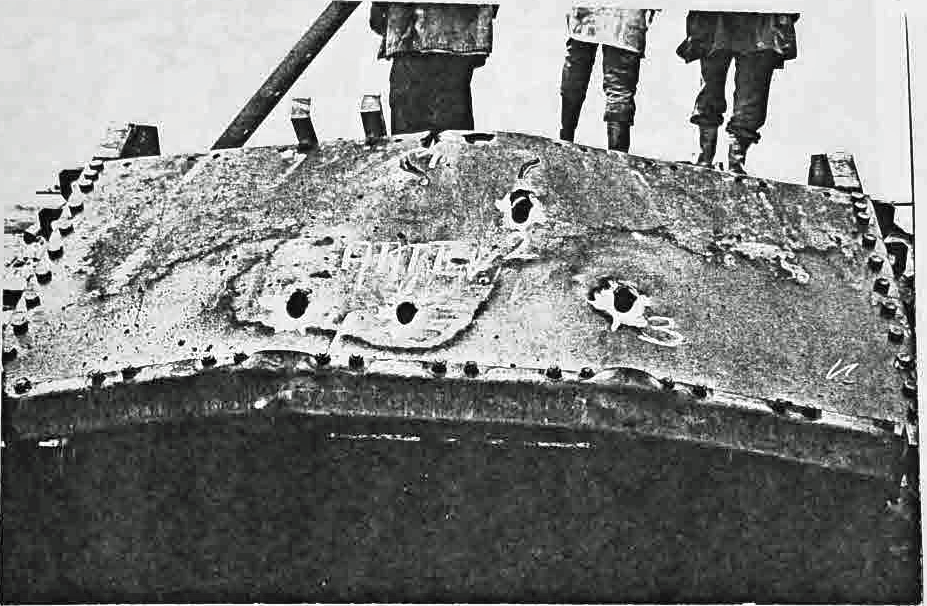
The front plate shown in image 5 was formed by a single 1 x 2 metres steel plate, which bulged considerably during the firing trials. Given that the buldging of the cover plates is supposedly a vital part to the APFSDS defeat mechanisms of ERA designs such as the Soviet Kontakt-5, one could speculate that using smaller plates that weren’t affected from the bulging of previous hits could have been beneficial to protection performance.
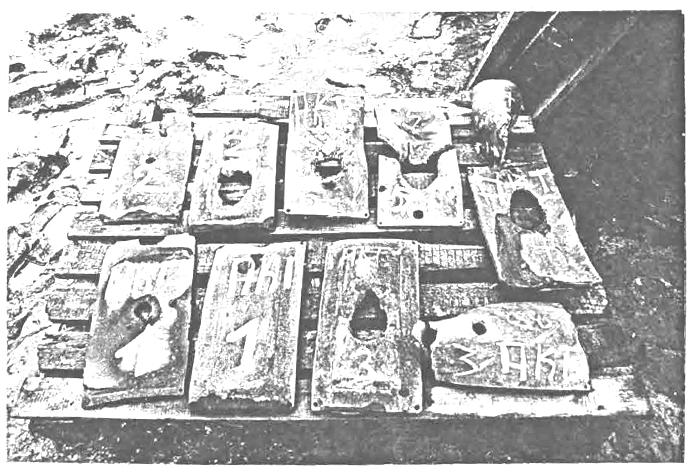
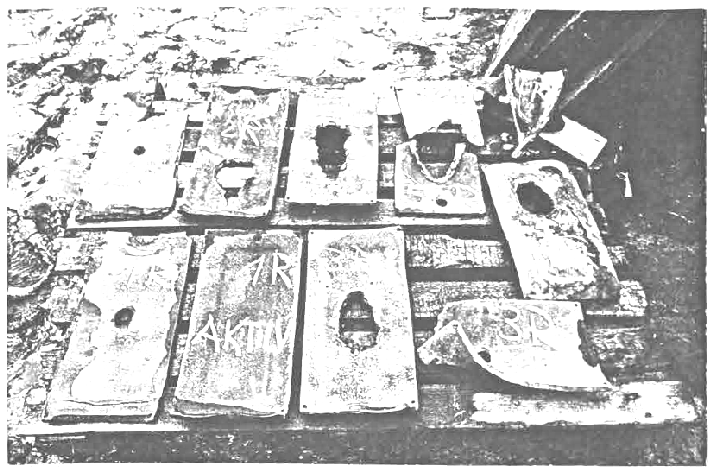
The flyer plates (called something along the lines of “overlaid plates” in the original source) showed large holes from the penetration except for the plates of the active sandwich that was missed. Two flyer plate pairs were torn apart from the penetration. The physical size of the holes suggest that using smaller, but more ERA tiles could have been used instead in order to improve multi-hit capability and reduce the weakspot created by the detonation of an ERA tile.
2.2 Test protocol of trial program 21
In the test program 21, the composition of the armor array – which again was mounted on a (possibly simulated) Leopard 1 hull – was alterted between the shots to investigate the impact of a frontal cover plate on the protective performance of the active armor against large calibre KE rounds.
For the first two shots, no front plate was used. For the shots number 3, number 4, number 5 and number 6, the report lists that a 20 mm thick plate of HZB 20 steel of the quality grade A was utilized. The seventh shot was fired against the active armor array with a 20 mm thick front plate made of HZB 20 W steel instead.
Spaced 100 millimetres behind the front plate (if present), an active sandwich consisting of a 3 mm thick plate made of Himalaja steel, a 5 mm layer of explosives and a 10 mm back plate made of Himalaja steel were mounted. 175 mm behind the active sandwich and 145 mm in front of the frontal hull armor plate, a 115 mm thick witness plate (also described as “rear armor”) made of HZB 20 A steel was located.
A more detailed description of the armor array can again be found in the first article.

| Shot number | Date | V50m | Front plate | Result at witness plate |
| 1 | 14.11.1977 | 1,363 m/s | not mounted | D, 15 mm deep penetration into hull |
| 2 | 14.11.1977 | 1,363.4 m/s | not mounted | D, 15 mm deep penetration into hull |
| 3 | 15.11.1977 | 1,369.8 m/s | 20 mm HZB 20 A | D, 6 mm deep penetration into hull |
| 4 | 15.11.1977 | 1,374.5 m/s | 20 mm HZB 20 A | BOR, 95 mm deep partial penetration |
| 5 | 17.11.1977 | 1,376.7 m/s | 20 mm HZB 20 W* | BOR, 105 mm deep partial penetration |
| 6 | 17.11.1977 | 1,362.3 m/s | 20 mm HZB 20 W* | BOR, 85 mm deep partial penetration |
| 7 | 18.11.1977 | 1,383 m/s | 20 mm HZB 20 W | D, OW for ERA, OM at hull armor plate |
*While the test protocols list that for shot 5 and shot 6 a HZB 20 A plate was used, the summary of the trial results and the description of the test purpose suggest that a HZB 20 W plate was used instead.
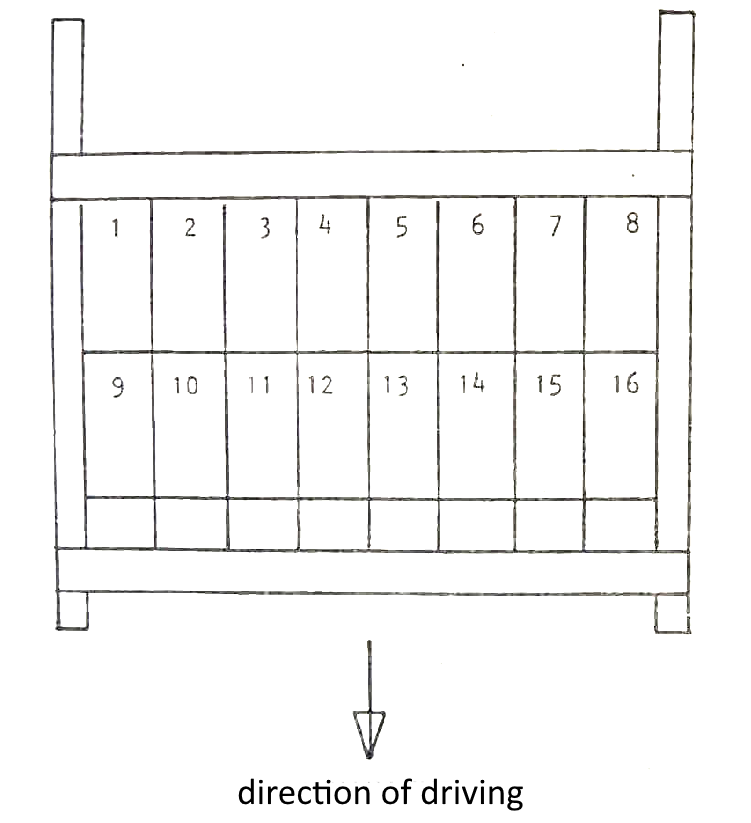
During the trial program 21, not all ERA panels (active armor sandwiches) were fitted; depending on shot only some were placed to investigate the detonation behaviour when hit. The following table summarizes which ERA panels were placed for each individual shot and how they reacted.
| Shot number | ERA panels placed | ERA panels detonated | ERA panels burnt | ERA panels left |
| 1 | 5, 6, 7, 13, 14 &15 | 14 | 5, 7, 13 | 6, 14 |
| 2 | 13 | 13 | – | – |
| 3 | 12 | 12 | – | – |
| 4 | 11 | 11 | – | – |
| 5 | 10 | 10 | – | – |
| 6 | 6, 7, 8, 14, 15 & 16 | 7 | 6 | 8, 14, 15 & 16 |
| 7 | 8 | 8 | – | – |
Every time an active armor sandwich was hit and detonated, it caused significant damage to the mounting frame, deforming or tearing it appart while also loosening the screws used to secure the panels. During shot six the Dottikon foil of four ERA panels was pushed away by the detonation of ERA panel number 7.
For the seventh shot, the crystalline PETN was used instead of Dottikon. The edge next to active armor sandwich was hit, detonating the explosives by the shock of the nearby impact without even hitting the ERA itself. The shot was not counted.

There are some oddities regarding the protocol of trial program 21. While the description of the target set-up in section 1.21 mentions that the stand-off distance between active armor sandwich and witness plate would be 160 mm, the test protocol always lists a distance of 175 mm; likewise the distance between witness plate and the hull frontal armor is supposed to range between 60 and 190 millimetres depending on test, but it is always listed as 145 mm in the test.
Another weird fact is that several slots for the active armor sandwiches were never used during tests – i.e. in the slots 1, 2, 3, 4 and 9 no ERA panel was placed during the firing trials, but image 12 shows a photograph with twelve active sandwiches mounted – including sandwiches in slots 1 to 4. Obviously image 12 might have been staged to showcase the layout/mounting mechanism of the target set-up, but a photograph taken before shot 1 or shot 6 should have had a similar effect.
Last but not least there are conflicts between section 2.1 and the later section 2.4.2. While the test protocol list the KE/38 round as KE projectile during these tests (as specified in section 1.1 in the earlier article), section 2.4.2 lists the KE/32 round. This is likely an error, but it is worth noting that the KE/38 round is correctly listed in section 2.4.2’s summary of the earlier trial program 16. Based on Swedish tests, the KE/32 round is a lot more capable than the older design. Furthermore the test protocol suggests that for four shots a HZB 20 steel plate of the quality grade A was used; the summary in section 2.4.2 specifically states that for shots 3 and 4 the quality grade A was used, while for shots 5 and 6 steel of the quality grade W was used.
2.2 Test protocol of trial program 22
In trial program 22 only two threats were used: a Milan shaped charge warhead (⌀ 96 mm) was fuzed in a static set-up two calibers (192 mm) in front of the front plate of the target, while a single shot (105 mm KE/38) was fired from 100 metres distance.
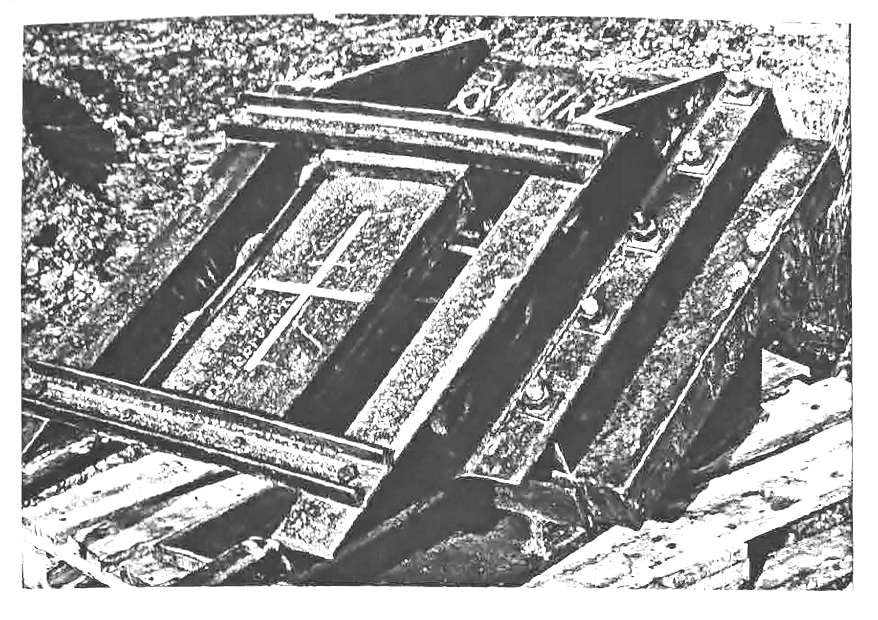
The target is described in article 1 with greater detail, but it consisted of a 20 mm HZB 301-V front plate spaced 100 mm in front of an active armor sandwich. The ERA panel was formed by two Himalaja steel plates (3 mm at the front, 10 mm at the back) with a five millimetre thick interlayer made of explosives. During the Milan test Dottikon was used, while the sandwich included crystalline Nitropenta (PETN) during the KE test. 175 mm behind the active armor sandwich, two 80 mm thick HZB 20 A witness plates were located. Like all test targets, the whole array was sloped at 60° NATO angle.
In image 14 the test set-up (seemingly without front plate) is shown. As the target was only used for two shots and the trial programs 21 already was used to study the behaviour of nearby active sandwiches, the physical size of the target was a lot smaller. The target was seemingly also not designed to withstand as many successive hits as the others.
When hit by the Milan warhead, the shaped charge jet detonated the Dottikon layer without the help of an external ignition, then penetrated the first witness plate, while a 15 mm deep perforation was found in the second witness plate. Likewise crystalline non-phlegmatised PETN detonated on impact of the KE round without the help of an external ignition, resulting in the projectile penetrating the first witness plate and creating a 25 mm deep perforation into the second one.
According to the drawing in section 1.2.3, the front plate was not used for the firing trials with KE ammunition, but it is listed as mounted in the test protocol.
2.4 Discussion of the results
2.4.1 Discussion of the results of trial program 16
The large-scale (1,000 mm x 2,000 mm) adapted active frontal hull add-on armor is divided into 16 individual active units. Each division should enable that upon firing against the active armor only respectively the active sandwich that was hit reacts. Thus on one hand the amount of reacting explosive mass is kept small; on the other hand the other effect units [ERA panels] remain intact. As the probability for a potentially following hit to hit the same spot won’t be very large, the array essentially retains its protection capacity.
B – TU 1911/00, page 49
Previous experiments as part of the trial programs 11 and 12 have lead to the usage of an explosive foil with external ignition. The aim of the trial program 16 was to determine if the detonative reaction of the explosive foil lead to an improved protection against large-caliber KE ammunition; it was not the aim to find an alternative to the external ignition (that was investigated as part of trial program 22).
Five shots were fired at the test set-up. The first shot hit the edge, that only grazed the test set-up and was not counted. Shot five was an inert shot used for comparison. A summary of the trial results is given in table 2. In the overview of the firing results can be seen, that compared to an inert firing an reduction in penetration depth by ca. 10% can be achieved with the active armor. Thus it could be proven that an increase in protection capacity compared to an inert armor array against large caliber KE ammunition (105 mm) can be achieved with an active armor array.
B – TU 1911/00, page 49
| Shot number | Ammunition | V50m | Explosive | External ingition | Penetration depth [mm] |
| 1 | KE/38; +21°C | 1,369.9 m/s | Dottikon | yes | OW, hit the edge |
| 2 | KE/38; +21°C | 1,372.1 m/s | Dottikon | yes | 256 |
| 3 | KE/38; +21°C | 1,375 m/s | Dottikon | yes | 266 |
| 4 | KE/38; +21°C | 1,362.9 m/s | Dottikon | yes | 252 |
| 5 | KE/38; +21°C | 1,369 m/s | – | – | > 280 |
Note that the table’s third column is labelled V50m, but should actually contain the V30m velocities.
2.4.2 Discussion of the results of trial program 21
With the studies of the trial program 21, it should be determined which influcence the front plate has on the protection capacity of an active armor array.
The object of the investigation was a large scale (1,000 mm x 2,000 mm) adapted active hull front add-on armor, which was divided into 16 active units. In two experiments the influence of the hit sandwiches on the surrounding sandwiches could be studied. The durability of the sandwiches’ mounting mechanism showed that it needs to be improved. An overview of the trial resutls is given in table 3.
Shots 1 and 2 were fired at the test set-up without front plate. For these shots the trigger time varied. The trigger foil was placed directly on the frontal overlaid plate [flyer plate] of the active sandwich.
For shots 3 and 4 a 20 mm thick front plate of quality grade A was installed, for shot 5 and 6 a corresponding front plate of quality grade W.
The trial results provide indications that the front plate improves the unfolding of the effect of the active armor. The influence of a front plate with greater strength apparently has a more favourable effect than the infleunce of a front plate with lower strength.
The listed results are single results and can therefore only be used as guide values.
Shot 7 is a follow-up test to trial program 22 and will be explained in section 2.4.3
B – TU 1911/00, page 51
| Shot number | Ammunition | V50m | Explosive | External ignition trigger time [µs] | Penetration depth |
| 1 | KE/32; +21°C | 1,363 m/s | Dottikon | 44 | 286 |
| 2 | KE/32; +21°C | 1,363.4 m/s | Dottikon | 2 | 286 |
| 3 | KE/32; +21°C | 1,369.8 m/s | Dottikon | 150 | 308 |
| 4 | KE/32; +21°C | 1,374.5 m/s | Dottikon | 150 | 256 |
| 5 | KE/32; +21°C | 1,376.7 m/s | Dottikon | 150 | 276 |
| 6 | KE/32; +21°C | 1,362.3 m/s | Dottikon | 160 | 236 |
| 8 | KE/32; +21°C | 1,383.3 m/s | PETN crystalline | – | 296 |
For some reason the seventh shot is listed as shot number 8 in the table 2, while the test protocol only lists seven shots. It seems that shot 7 and 8 are identical. Furthermore the table incorrectly lists the KE/32 ammunition, while according to the test protocol and section 1.1. the KE/38 ammunition was used.
In this trrial program, the best protective performance was achieved: the penetration of the sixth shot was reduced by ca. 25% compared to an inert hit (as the seventh shot missed its target, one could argue that it might closely represent the results of an inert shot). However in case of the third shot, the penetration was higher than in case of shot number 7.
2.4.3 Discussion of the results of trial program 22
The studies of the trial program 22 were conducted against single targets. The protection capacity of an active armor array against a 96 mm shaped charge was to be determined, while on the other hand instead of the previously used explosive foil of the company Schweizerische Sprengstoff-Fabrik crystalline nitropenta (non-phlegmatised) was to be used in the active armor array. The study applied to prove how crystalline non-phlegmatised nitropenta could be initiated to detonate upon projectile impact, if so by reducing the share of phlegmatizing means can be created, which reacts via detonating on projedctile impact.
An overview of the trial results is given in table 4.
It could be observed that a self-ignition of the explosive nitropentra is fundamentally achievable. Thus it seems to be within the realm of possibility to created an explosive foil based on nitropenta, which is suited to react on projectile impact with a detonation.
The margin in which a suitable mixing ratio of nitropentra to phlegmatizing means should lie, has been first limited by the trials. A desired mixing ratio of nitropenta/phlegmatizer must be between pure nitropenta (100% PETN; 0% phelgmatizer) and the mixing ratio of the used rubber-elastic explosive foil (85% PETN; 15% phelgmatizer).
B – TU 1911/00, page 53
| Shot number | Ammunition | V50m [m/s] | Explosive | External ignition trigger time [µs] | Penetration depth [mm] |
| SC – detonation | 96 mm SC | – | Dottikon | – | 256 |
| 7 | KE/32; + 21°C | 1,380.4 | PETN crystalline | – | 236 |
It appears again that the table incorrectly lists the KE/32 round, while the test protocol and section 1.1. list the KE/38 round.
A second prepared explosive charge made of crystalline non-phelgmatised nitropenta was used in trial program 21 and fired at (shot 7). The shot missed the active sandwich and thus cannot be counted. The crystalline non-phlegmatised nitrpoenta proved to be so sensititve, that even the missing shot lead to its detonation.
B – TU 1911/00, page 55
3. Outlook
It seems that all three trial programs were succesess. Trial program 16 proved that the active armor array could improve protection against KE rounds and that some ERA panels in the current construction could be damaged/burnt by nearby impacts, while others could remain intact – i.e. it showed the where further optimizations were needed.
Trial program 21 meanwhile proved that the protection provided by a ERA against 105 mm APFSDS rounds was influenced by the cover plate of the ERA array; the stronger the cover plate, so better was the protection.
Trial program 22 showed that crystalline non-phlegmatised PETN could be detonated by projectile impact, while Dottikon could be detonated by shaped charge hits – without the need of an external fuze – and that it improved protection against shaped charges (in this specific test by ca. 250-260 mm). The crystalline PETN proved to be too sensitive for use in ERA, but it provided a data point for the creation of a better explosive mix (with more than 0% but less than 15% phelgmatizers).
The studies show that when using external ignition (via the projectile igniting an explosive charge with the help of an instantenous fuse by passing through the trigger foil) a protective effect of an active armor array against large calibre KE ammunition can be achieved. The initiation of the used explosive foil via the projectile impact was not possible.
When reducing the amount of phlegmatic substances mixed into the explosive foil, the initiation of a detonation of the changed explosive mix is to be expected upon projectile impact.
With the help of the performed experiments it was shown that the detonation initiation of a nitropenta based explosive mix by projectile impact should be fundamentally possible. (Experiments with crystalline non-phlegmatised nitropenta.)
Without an explosive material that reacts with self-ignition experiments with active armor arrays are only possible, when the currently used explosive foil is initiated using external ignition. Thus, important questions of target design for increasing the protective effect of active armor can already be investigated.
B – TU 1911/00, page 55
